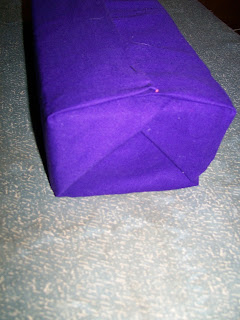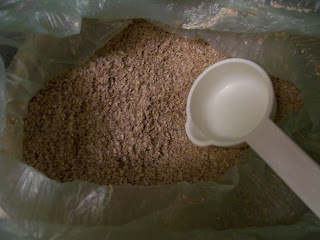Step 1: Procure a brick. It should be clean and new; I took a used brick and washed off the surface dirt. Miss Leslie would certainly not approve.
Step 2: Cut a piece of "coarse linen or strong domestic cotton" large enough to cover the brick.
Step 3: Fold the fabric over the brick, neatly, and stitch it down.
Step 4: Cut a bag of coarse linen 2" larger* than the top of the brick. For a thicker pin cushion, cut the bag a little larger still.
Step 5: Stuff the bag with bran. Like, a lot--until no more bran will fit, even when pushed down with a spoon. It took approximately 1 lb. of wheat bran to fill a bag cut 2" longer on each side than a standard brick.
Step 6: Attach the bran bag to the brick. It should have a "good shape" with the sides of the cushion sloping down to the brick. I don't think I quite managed it.
 |
| It looks like a loaf of bread. |
Step 8: Cover the pincushion in "velvet, silk, or cloth" with a "binding of narrow ribbon or galloon" over the seam. Two colors may be used to cover the top and bottom portions of the pincushion.
The book illustration showed no seams or binding, just a shadow between the brick and cushion areas (which seems the only logical place for the ribbon). Unlike step 3, the instructions don't suggest a method for covering, so I just sort of made it up, wrapping the pincushion form like a present, and folding/pinching out the excess fabric. It resulted in some ugly curved seams at the rounded edges. Next time, I think I'd make the cover in two parts, folded square around the base, and smoothed over the sloping top, with the ribbon covering the seam where they meet.
Comparing mine to the book image, I see two main differences. First, the brick used appears flatter and to have a more square footprint. Perhaps some sort of cobble or small paving stone would give a shape closer to the sketch. Second, the cushion appears outsized in my version: I now think the "2 inches" difference was meant to be added to the total measurement of the bag, rather than to each side.








Nicely done. These are so useful; a favorite at the museum. I've had smaller versions on my to-do list for a long while.
ReplyDeleteThanks! I started your sew-along bag project a few months late, and have been using the long gathering seams as an excuse to try out the brick. Slowly starting to figure it out (the brick, that is, the bag instructions are quite clear).
Delete